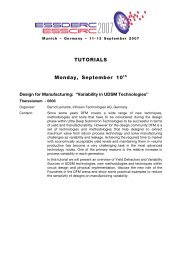Mixed-Signal-Electronics - Lehrstuhl für Technische Elektronik - TUM
Mixed-Signal-Electronics - Lehrstuhl für Technische Elektronik - TUM
Mixed-Signal-Electronics - Lehrstuhl für Technische Elektronik - TUM
You also want an ePaper? Increase the reach of your titles
YUMPU automatically turns print PDFs into web optimized ePapers that Google loves.
Representation of Discrete Time <strong>Signal</strong>s and<br />
Spectral Transformation<br />
Spectrum of a sampled signal:<br />
s(t) = X<br />
±(t ¡ nT ) $ S(!) = 2¼<br />
T<br />
n<br />
xs(t) = xc(t) ¢ s(t) $<br />
Sampling means multiplication<br />
of continuous time signal with<br />
pulse train<br />
X<br />
Henzler, Schmitt-Landsiedel <strong>Mixed</strong>-<strong>Signal</strong>-<strong>Electronics</strong> 2011/12<br />
k<br />
±(! ¡ k!s) !s = 2¼<br />
T<br />
Xs(!) = 1<br />
2¼ Xc(!) ¤ S(!)<br />
= 1<br />
T Xc(!) ¤ X<br />
= 1<br />
T<br />
X<br />
k<br />
In frequency domain this translates<br />
into convolution of signal spectrum<br />
with spectrum of pulse train.<br />
This is simply a copy and shift of<br />
the spectrum to multiples of the<br />
sampling frequency<br />
k<br />
Xc(! ¡ k!s)<br />
±(! ¡ k!s)<br />
22











